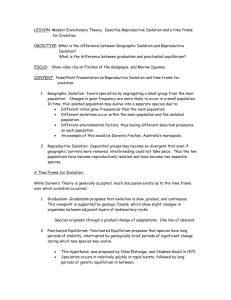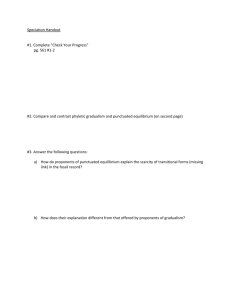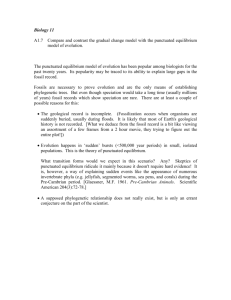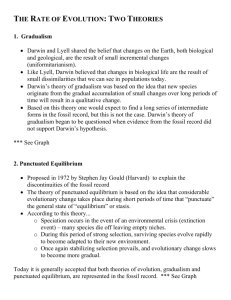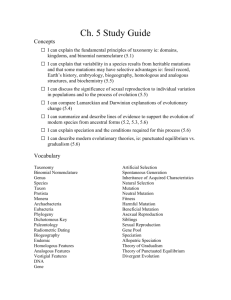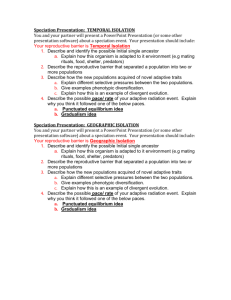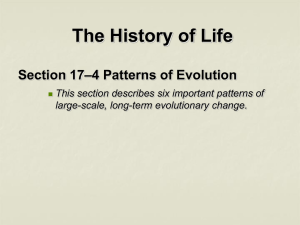Honors Biology Lesson Notes 5 Unit 11
advertisement
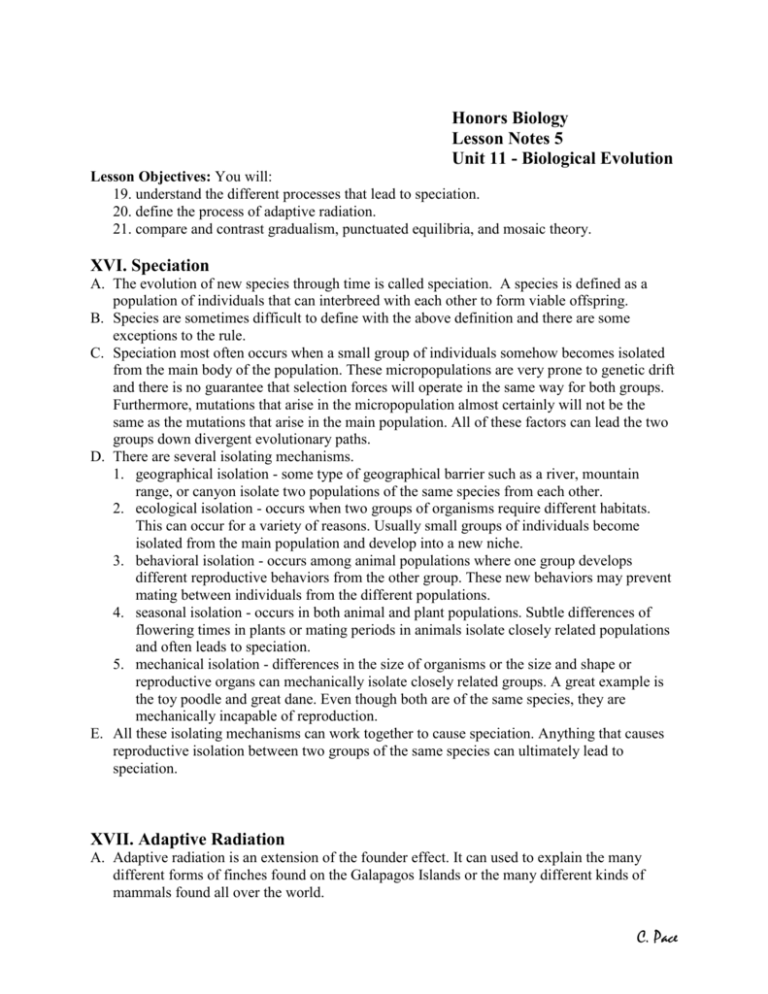
Honors Biology Lesson Notes 5 Unit 11 - Biological Evolution Lesson Objectives: You will: 19. understand the different processes that lead to speciation. 20. define the process of adaptive radiation. 21. compare and contrast gradualism, punctuated equilibria, and mosaic theory. XVI. Speciation A. The evolution of new species through time is called speciation. A species is defined as a population of individuals that can interbreed with each other to form viable offspring. B. Species are sometimes difficult to define with the above definition and there are some exceptions to the rule. C. Speciation most often occurs when a small group of individuals somehow becomes isolated from the main body of the population. These micropopulations are very prone to genetic drift and there is no guarantee that selection forces will operate in the same way for both groups. Furthermore, mutations that arise in the micropopulation almost certainly will not be the same as the mutations that arise in the main population. All of these factors can lead the two groups down divergent evolutionary paths. D. There are several isolating mechanisms. 1. geographical isolation - some type of geographical barrier such as a river, mountain range, or canyon isolate two populations of the same species from each other. 2. ecological isolation - occurs when two groups of organisms require different habitats. This can occur for a variety of reasons. Usually small groups of individuals become isolated from the main population and develop into a new niche. 3. behavioral isolation - occurs among animal populations where one group develops different reproductive behaviors from the other group. These new behaviors may prevent mating between individuals from the different populations. 4. seasonal isolation - occurs in both animal and plant populations. Subtle differences of flowering times in plants or mating periods in animals isolate closely related populations and often leads to speciation. 5. mechanical isolation - differences in the size of organisms or the size and shape or reproductive organs can mechanically isolate closely related groups. A great example is the toy poodle and great dane. Even though both are of the same species, they are mechanically incapable of reproduction. E. All these isolating mechanisms can work together to cause speciation. Anything that causes reproductive isolation between two groups of the same species can ultimately lead to speciation. XVII. Adaptive Radiation A. Adaptive radiation is an extension of the founder effect. It can used to explain the many different forms of finches found on the Galapagos Islands or the many different kinds of mammals found all over the world. C. Pace B. Adaptive radiation is the evolution of a variety of descendant species from one parent species. For adaptive radiation to occur there must be little competition and a variety of unfilled habitats. C. The most famous example of the adaptive radiation process is probably the Galapagos finches. But, adaptive radiation also occurs on a grander scale. Imagine a world of dinosaurs suddenly becoming a world without dinosaurs. What is going to take their place? Remember, there is all of sudden very little competition and a wide variety of unfilled habitats. It may also be helpful to know that very primitive rodent like mammals existed through the entire reign of dinosaurs which lasted for well over 100 million years. Think about it? XVIII. Theories About the Rate of Evolution A. Darwin visualized evolution proceeding at a very slow pace that took millions of years and encompassed many small changes that lead to the development of new species. This has come to be known as gradualism. B. However, the fossil record in general does not support gradualism and has lead scientists to propose new theories on how evolution marches through time. One of these theories that has gained wide notice is called punctuated equilibrium. C. The basic idea behind punctuated equilibrium is that there are long stable periods where little or no evolutionary change takes place, followed by short,rapid bursts in the rate of evolution. This new theory seems to explain known facts about the fossil record. D. Some scientists have even tried to combine the theories of gradualism and punctuated equilibrium to form a new theory called mosaic theory. This theory takes the position that both gradualism and punctuated equilibrium can be used to describe the fossil record. That is the the general pace of evolution is slow (gradualism) with short periods of rapid evolutionary change (punctuated equilibrium). C. Pace


